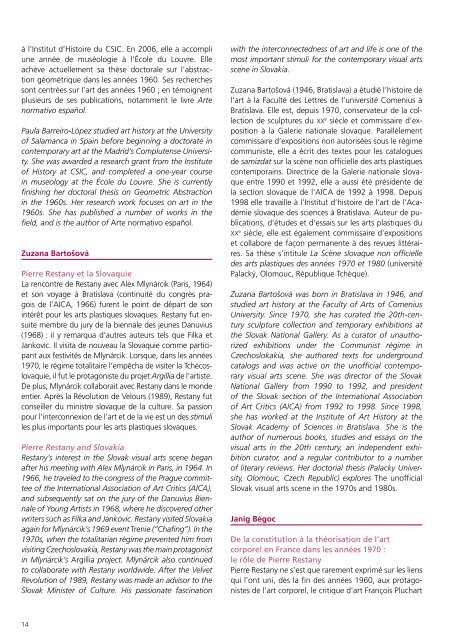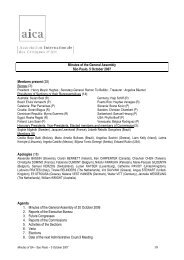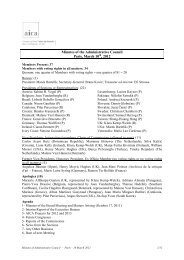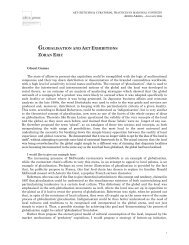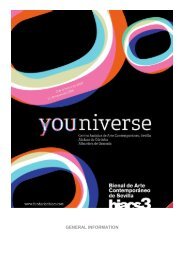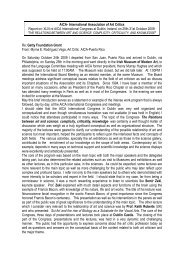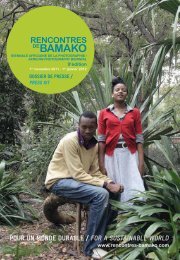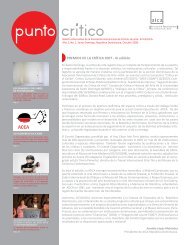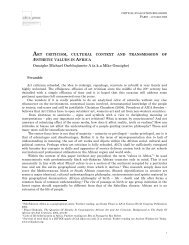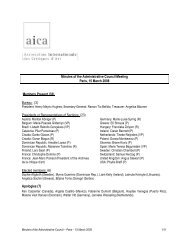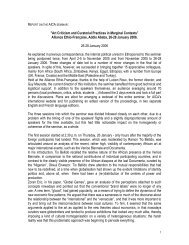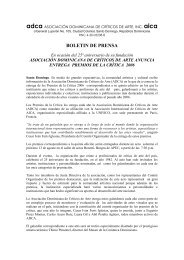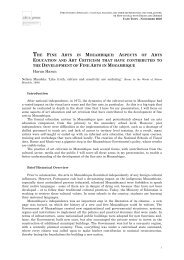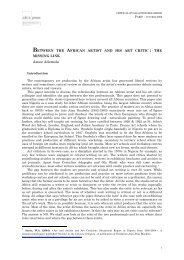Pierre Restany Pierre Restany's - AICA international
Pierre Restany Pierre Restany's - AICA international
Pierre Restany Pierre Restany's - AICA international
Create successful ePaper yourself
Turn your PDF publications into a flip-book with our unique Google optimized e-Paper software.
à l’Institut d’Histoire du CSIC. En 2006, elle a accompli<br />
une année de muséologie à l’École du Louvre. Elle<br />
achève actuellement sa thèse doctorale sur l’abstraction<br />
géométrique dans les années 1960. Ses recherches<br />
sont centrées sur l’art des années 1960 ; en témoignent<br />
plusieurs de ses publications, notamment le livre Arte<br />
normativo español.<br />
Paula Barreiro-López studied art history at the University<br />
of Salamanca in Spain before beginning a doctorate in<br />
contemporary art at the Madrid’s Complutense University.<br />
She was awarded a research grant from the Institute<br />
of History at CSIC, and completed a one-year course<br />
in museology at the École du Louvre. She is currently<br />
finishing her doctoral thesis on Geometric Abstraction<br />
in the 1960s. Her research work focuses on art in the<br />
1960s. She has published a number of works in the<br />
field, and is the author of Arte normativo español.<br />
Zuzana Bartošová<br />
<strong>Pierre</strong> <strong>Restany</strong> et la Slovaquie<br />
La rencontre de <strong>Restany</strong> avec Alex Mlynárcik (Paris, 1964)<br />
et son voyage à Bratislava (continuité du congrès pragois<br />
de l’<strong>AICA</strong>, 1966) furent le point de départ de son<br />
intérêt pour les arts plastiques slovaques. <strong>Restany</strong> fut ensuite<br />
membre du jury de la biennale des jeunes Danuvius<br />
(1968) : il y remarqua d’autres auteurs tels que Filka et<br />
Jankovic. Il visita de nouveau la Slovaquie comme participant<br />
aux festivités de Mlynárcik. Lorsque, dans les années<br />
1970, le régime totalitaire l’empêcha de visiter la Tchécoslovaquie,<br />
il fut le protagoniste du projet Argillia de l’artiste.<br />
De plus, Mlynárcik collaborait avec <strong>Restany</strong> dans le monde<br />
entier. Après la Révolution de Velours (1989), <strong>Restany</strong> fut<br />
conseiller du ministre slovaque de la culture. Sa passion<br />
pour l’interconnexion de l’art et de la vie est un des stimuli<br />
les plus importants pour les arts plastiques slovaques.<br />
<strong>Pierre</strong> <strong>Restany</strong> and Slovakia<br />
<strong>Restany</strong>’s interest in the Slovak visual arts scene began<br />
after his meeting with Alex Mlynárcik in Paris, in 1964. In<br />
1966, he traveled to the congress of the Prague committee<br />
of the International Association of Art Critics (<strong>AICA</strong>),<br />
and subsequently sat on the jury of the Danuvius Biennale<br />
of Young Artists in 1968, where he discovered other<br />
writers such as Filka and Jankovic. <strong>Restany</strong> visited Slovakia<br />
again for Mlynárcik’s 1969 event Trenie (“Chafing”). In the<br />
1970s, when the totalitarian régime prevented him from<br />
visiting Czechoslovakia, <strong>Restany</strong> was the main protagonist<br />
in Mlynárcik’s Argillia project. Mlynárcik also continued<br />
to collaborate with <strong>Restany</strong> worldwide. After the Velvet<br />
Revolution of 1989, <strong>Restany</strong> was made an advisor to the<br />
Slovak Minister of Culture. His passionate fascination<br />
with the interconnectedness of art and life is one of the<br />
most important stimuli for the contemporary visual arts<br />
scene in Slovakia.<br />
Zuzana Bartošová (1946, Bratislava) a étudié l’histoire de<br />
l’art à la Faculté des Lettres de l’université Comenius à<br />
Bratislava. Elle est, depuis 1970, conservateur de la collection<br />
de sculptures du xx e siècle et commissaire d’exposition<br />
à la Galerie nationale slovaque. Parallèlement<br />
commissaire d’expositions non autorisées sous le régime<br />
communiste, elle a écrit des textes pour les catalogues<br />
de samizdat sur la scène non officielle des arts plastiques<br />
contemporains. Directrice de la Galerie nationale slovaque<br />
entre 1990 et 1992, elle a aussi été présidente de<br />
la section slovaque de l’<strong>AICA</strong> de 1992 à 1998. Depuis<br />
1998 elle travaille à l’Institut d’histoire de l’art de l’Académie<br />
slovaque des sciences à Bratislava. Auteur de publications,<br />
d’études et d’essais sur les arts plastiques du<br />
xx e siècle, elle est également commissaire d’expositions<br />
et collabore de façon permanente à des revues littéraires.<br />
Sa thèse s’intitule La Scène slovaque non officielle<br />
des arts plastiques des années 1970 et 1980 (université<br />
Palacký, Olomouc, République Tchèque).<br />
Zuzana Bartošová was born in Bratislava in 1946, and<br />
studied art history at the Faculty of Arts of Comenius<br />
University. Since 1970, she has curated the 20th-century<br />
sculpture collection and temporary exhibitions at<br />
the Slovak National Gallery. As a curator of unauthorized<br />
exhibitions under the Communist régime in<br />
Czechoslokakia, she authored texts for underground<br />
catalogs and was active on the unofficial contemporary<br />
visual arts scene. She was director of the Slovak<br />
National Gallery from 1990 to 1992, and president<br />
of the Slovak section of the International Association<br />
of Art Critics (<strong>AICA</strong>) from 1992 to 1998. Since 1998,<br />
she has worked at the Institute of Art History at the<br />
Slovak Academy of Sciences in Bratislava. She is the<br />
author of numerous books, studies and essays on the<br />
visual arts in the 20th century, an independent exhibition<br />
curator, and a regular contributor to a number<br />
of literary reviews. Her doctorial thesis (Palacky University,<br />
Olomouc, Czech Republic) explores The unofficial<br />
Slovak visual arts scene in the 1970s and 1980s.<br />
Janig Bégoc<br />
De la constitution à la théorisation de l’art<br />
corporel en France dans les années 1970 :<br />
le rôle de <strong>Pierre</strong> <strong>Restany</strong><br />
<strong>Pierre</strong> <strong>Restany</strong> ne s’est que rarement exprimé sur les liens<br />
qui l’ont uni, dès la fin des années 1960, aux protagonistes<br />
de l’art corporel, le critique d’art François Pluchart<br />
14


